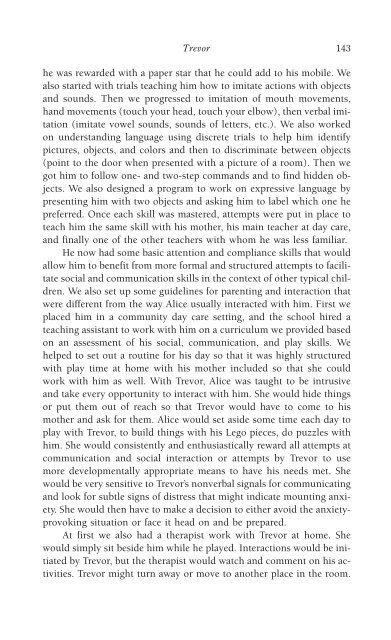978-1572305441
autism
autism
Create successful ePaper yourself
Turn your PDF publications into a flip-book with our unique Google optimized e-Paper software.
Trevor 143<br />
he was rewarded with a paper star that he could add to his mobile. We<br />
also started with trials teaching him how to imitate actions with objects<br />
and sounds. Then we progressed to imitation of mouth movements,<br />
hand movements (touch your head, touch your elbow), then verbal imitation<br />
(imitate vowel sounds, sounds of letters, etc.). We also worked<br />
on understanding language using discrete trials to help him identify<br />
pictures, objects, and colors and then to discriminate between objects<br />
(point to the door when presented with a picture of a room). Then we<br />
got him to follow one- and two-step commands and to find hidden objects.<br />
We also designed a program to work on expressive language by<br />
presenting him with two objects and asking him to label which one he<br />
preferred. Once each skill was mastered, attempts were put in place to<br />
teach him the same skill with his mother, his main teacher at day care,<br />
and finally one of the other teachers with whom he was less familiar.<br />
He now had some basic attention and compliance skills that would<br />
allow him to benefit from more formal and structured attempts to facilitate<br />
social and communication skills in the context of other typical children.<br />
We also set up some guidelines for parenting and interaction that<br />
were different from the way Alice usually interacted with him. First we<br />
placed him in a community day care setting, and the school hired a<br />
teaching assistant to work with him on a curriculum we provided based<br />
on an assessment of his social, communication, and play skills. We<br />
helped to set out a routine for his day so that it was highly structured<br />
with play time at home with his mother included so that she could<br />
work with him as well. With Trevor, Alice was taught to be intrusive<br />
and take every opportunity to interact with him. She would hide things<br />
or put them out of reach so that Trevor would have to come to his<br />
mother and ask for them. Alice would set aside some time each day to<br />
play with Trevor, to build things with his Lego pieces, do puzzles with<br />
him. She would consistently and enthusiastically reward all attempts at<br />
communication and social interaction or attempts by Trevor to use<br />
more developmentally appropriate means to have his needs met. She<br />
would be very sensitive to Trevor’s nonverbal signals for communicating<br />
and look for subtle signs of distress that might indicate mounting anxiety.<br />
She would then have to make a decision to either avoid the anxietyprovoking<br />
situation or face it head on and be prepared.<br />
At first we also had a therapist work with Trevor at home. She<br />
would simply sit beside him while he played. Interactions would be initiated<br />
by Trevor, but the therapist would watch and comment on his activities.<br />
Trevor might turn away or move to another place in the room.



